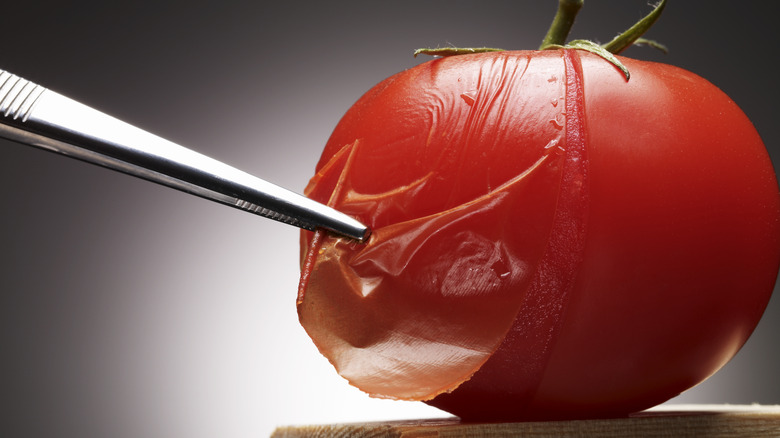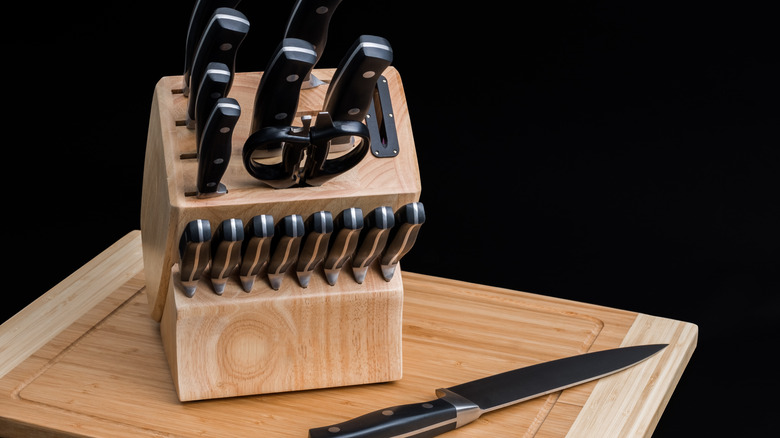Jacques Pépin's Tomato Trick To Test Your Kitchen Knives
Things you might not know about Jacques Pépin: The French-born chef learned his way around the kitchen at his parents' restaurant, Le Pelican, in his hometown of Bourg-en-Bresse, north of Lyon (per PBS). He recalls being assigned small tasks, like peeling potatoes and washing wine bottles. He embarked on his own career in food as a teenager, securing an apprenticeship at the Grande Hotel de L' Europe (per The New York Times). Opportunity knocked and would eventually lead the chef to Paris, where he cooked for French President Charles de Gaulle and other heads of state, and later to the United States, where he worked at restaurants, learned about marketing and mainstream American food tastes while working for the Howard Johnson Company, authored dozens of cookbooks, and teamed up in the kitchen and on TV sets with his friend Julia Child (per The Splendid Table).
If you're a Pépin fan like Andrew Zimmern, you probably appreciate that the legendary chef isn't all about "haute cuisine.” He's about fresh, seasonal ingredients, relatively simple preparations, putting leftovers to work in new and different ways for subsequent meals, and sharing tips and tricks, like scoring sweet potatoes before baking them to better soak up butter and honey.
How a tomato can determine your knife's sharpness
Jacques Pépin is 86 years young (per NPR), and his chef skills appear to be as sharp as ever. And so do his knives. Whether it's for his cooking shows on PBS or a short video from his home kitchen posted on Facebook or Instagram, just about everything the master chef creates begins with a large wooden cutting board and Pépin's enviably precise slicing, dicing, mincing, and chopping of ingredients like onions, peppers, and garlic.
The culinary king has hundreds of knives to work with at home, but far more important than quantity is the quality and sharpness of those knives (per Facebook). A good way to test how sharp your knives are is to grab a tomato — one that's nice and ripe — and slice into it (per Bon Appetit). A sharp knife will slice the tomato neatly, with no mess or shredded skin. The James Beard-award-winning chef is also a proponent of cutting boards fashioned from wood because wood won't dull the blades of knives. "A good cutting board, a good knife, a good cut, and that's it," Pépin says. He sure makes everything sound so easy.
Never a dull moment for Pépin and his knives
Variety is the spice of life, but Pépin, who told Food52 he has 300 knives, says most kitchen tasks can be accomplished with only three: An eight-inch chef's knife, a six- or seven-inch utility knife, and a four-inch paring knife (per Facebook). With this power trio, you can slice and dice up a storm. Rather than spending money on a fancy knife set, invest in "good quality” knives that feel comfortable in your hand — and be sure to keep them sharp. "A dull knife is more dangerous than a sharp one,” Pépin says.
There are several ways to keep knives sharp and ready for action with many knife sharpeners on the market. One of the best and simplest ways to sharpen a knife is with steel, a tool that somewhat resembles a steel wand, but with a handle. If you look at your knife under a microscope, says Pépin, you'll see that the blade has tiny teeth, which get "out of whack” over time. Used correctly, the knife steel will "realign” a knife's teeth. The key is to apply a bit of pressure and run the knife from top to bottom over the steel, repeating several times. Do not slide the knife up and down the steel.
If you don't have a knife sharpener or steel hone at home, you can always use this unexpected item to sharpen your kitchen knives.


